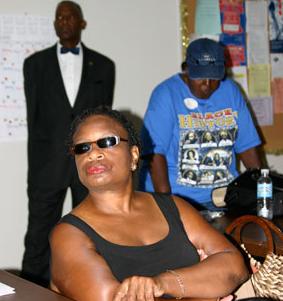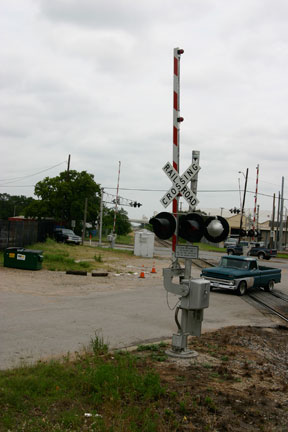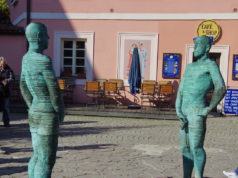Most folks who live near railroad tracks grow weary of getting blasted by train horns day and night. So when Fort Worth’s railroad projects manager Russell Wiles shows up in a neighborhood offering to establish a so-called quiet zone, he’s usually a welcome sight.
Not necessarily so in the Riverside area, however, where hot tempers and cold shoulders greeted Wiles when he spoke earlier this month to a couple of dozen residents at a community center, trying to convince them that t heir lives would be oh so much better without those pesky horns blaring.
heir lives would be oh so much better without those pesky horns blaring.
“They’ve got a hidden agenda,” said Sarah Walker, who grew up in the East Fort Worth neighborhood and isn’t sure what to make of the city’s offer. “We’ve been the stepchildren on this side of I-35 for a long time.”
Others got downright angry, accusing city officials of trying to force something down their throats.
Three times over the past 10 years, officials from the city or the Trinity Railway Express have shown up in this neighborhood to offer the city’s help in establishing a quiet zone, which prohibits trains from regularly blowing their horns at certain railroad crossings.
Elaborate gate systems or high-curbed medians that prevent motorists from driving around lowered railroad gates – and remove the need for trains to blow their horns – are two ways to create quiet zones. Riverside is being offered a combination of methods: Close down Galvez Avenue where it crosses the tracks (several accidents involving motorists and trains have occurred there since 2002, including a fatality in 2008). Then, the city would build a high-curbed median at Judkins Street and an elaborate gate system at Riverside Drive where those streets cross the tracks.
But residents want Galvez to remain open. And they say it’s too dangerous for trains to run through their neighborhood without sounding horns as a warning.
“We have put this issue to bed three times,” said Phyllis Allen, who has lived in Riverside all her life and said the horns don’t bother her.
Currently, 37 passenger trains a day sound their horns while passing through the neighborhood. Accidents over the years have involved motorists who drove around lowered gates or otherwise broke the law and ended up colliding with the trains. You can’t legislate against stupidity, Allen said.
Those who came to the meeting at the Sessions Community Center said Galvez is an important east-west route through the neighborhood. Children play or walk near the train tracks, pedestrians cross the tracks in unmarked areas, and they all need to hear horns, residents told Wiles.
“It’s too dangerous to have a quiet zone,” Allen said.
She wonders if the city has something else up its sleeve, such as trying to gentrify the neighborhood. “Gentrification” can be a politically correct word that actually means running off poor people and transforming inner-city neighborhoods into hot real estate areas.
“The city has a vision for this neighborhood that doesn’t include us,” she said.
Wiles fielded questions with the patience of a man who seems intent on establishing a quiet zone in the neighborhood no matter how long it takes. He said the city has no ulterior motives for pushing change. The railroad crossing at Galvez is a safety hazard, pure and simple, he said. Galvez Avenue was built decades ago and crosses the Trinity Railway Express tracks at an angle that makes it difficult for motorists to see approaching trains. Three accidents in seven years is a testament to the crossing’s potential for danger, he said.
“We’d never design a road like this again,” he said.
Establishing quiet zones can be expensive, and the city has limited federal funding available. Of 194 railroad crossings around town, only a small percentage each year can be redesigned and turned into quiet zones. Wiles does studies to determine which crossings should be addressed first, based on criteria such as traffic counts, population density, numbers of accidents, proximity to schools, and whether or not the roads are routinely used by emergency personnel. There are currently 60 potential quiet zones slated citywide, and the Galvez crossing ranks high on the list.
 “Our job is to make sure your roads are safe,” Wiles told the residents during his presentation. “It’s a priority for a lot of neighborhoods, for people like you.”
“Our job is to make sure your roads are safe,” Wiles told the residents during his presentation. “It’s a priority for a lot of neighborhoods, for people like you.”
“Bullshit,” somebody said.
Walker said, “They need to tell the truth.”
Wiles tried another tack.
“If I lived on Galvez …” he said.
“I do live on Galvez!” a resident shouted.
Fort Worth City Council member Kathleen Hicks attended the meeting and said she wanted to hear what her constituents were thinking. But she also told them what she was thinking – she’s a light sleeper who doesn’t like train horns, and she gets calls from constituents complaining about noisy trains.
“I’ve been frustrated that there aren’t more quiet zones in District 8,” she said.
But Hicks soon found herself on the receiving end of some heated words, and she let loose after a man stood up and questioned the city’s true motives.
“Coming in here and trying to say I’m trying to run some kind of scam – I don’t appreciate that,” she said loudly. “I don’t roll that way.”
Eventually, she asked everyone in attendance how they felt about closing Galvez and establishing a quiet zone. All were opposed except one.
The city staff can recommend a quiet zone be established, and the city council has the ultimate power of approval, no matter what local residents want. But Hicks assured the crowd, “As long as I’m on the city council, I’m going to go with what the neighborhood wants.”
“You’re just one vote,” a resident countered.
Wiles acknowledged the city could establish a quiet zone without the neighborhood’s consent and may consider doing so.
“I’m not sure where we’ll go with this,” he said. “We do have a safety issue. It would be kind of remiss if we just dropped it.”
After the meeting, Wiles mailed out 600 surveys to Riverside residents asking them to vote yes or no on a quiet zone.
“We want to give everybody we can a say-so in this,” he said.
However, he said, with many neighborhoods clamoring to receive the upgrades and only limited funding, the quiet zones would more likely go to areas that want them.
That seems fine to the wary
Riverside folks.











